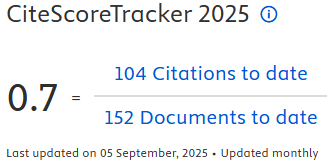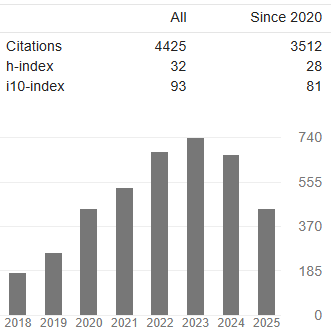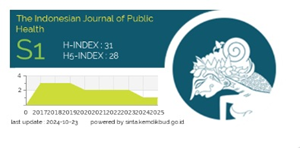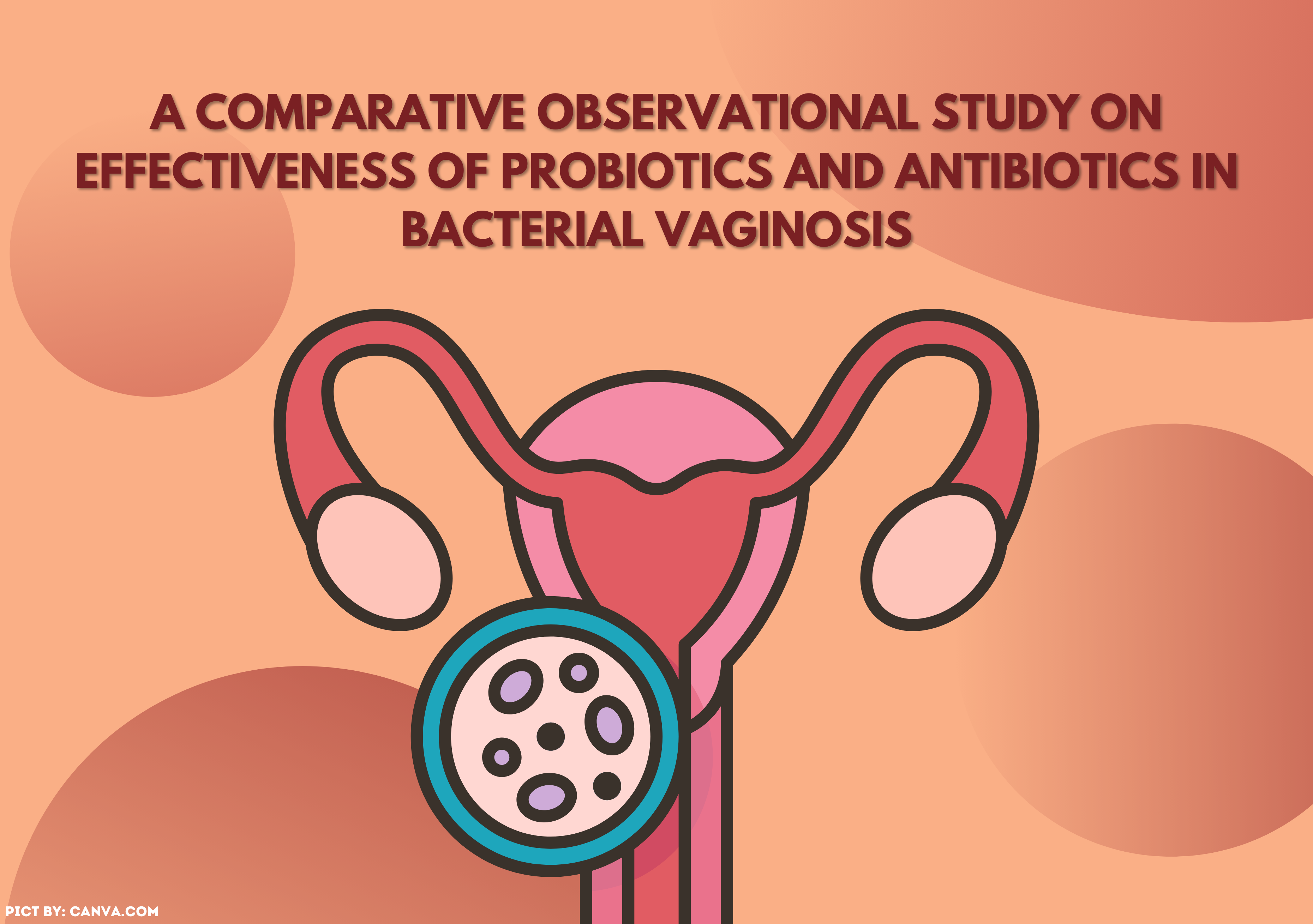INFLUENCE OF ATTITUDE, SUBJECTIVE NORM, PERCEIVED BEHAVIOUR CONTROL TO PERFORM INTENTION IN PREVENTION ACTION OF DIABETES
Downloads
Introduction: This study aimed to identify influence of attitude, subjective norm, and perceived behavior control to intention on preventive behavior of type II diabetes in Theory of Planned Behaviour model. Methods: This study is an observational study with a cross-sectional and analytical design. The population in this study were all undergraduate students of Public Health FKM UA. The sample was determined by using simple random sampling technique, until a total sample of 234 respondents was obtained. Result: Research on type II preventive behavior showed that respondents who agreed to the positive impact of preventive behavior of type II diabetes and had confidence that they could implement preventive behavior of type II diabetes by 70.08% of the total respondents. Respondents who had subjective norms agree on preventive behavior of type II diabetes and havmd the confidence to be able to perform preventive behavior for type II diabetes by 70.09% of the total respondents. Respondents who had the confidence to be able to interpret themselves were able to perform preventive behavior of type II diabetes and had confidence in carrying out preventive behavior for type II diabetes by 47.44% of the total respondents. Conslusion: Based on the results of the study showed that the attitude variable (P < 0.905) did not significantly influence the intention variable. While the subjective norm (P > 0,001) and perceived variables control (P > 0,001) significantly influence intention.
Keywords:Type II Diabetes Mellitus, Prevention, TPB
Akbar, H., Anderson, D., & Gallegos, D. (2015). Predicting Intentions and Behaviours in Populations With or At-Risk of Diabetes: A Systematic Review. Preventive Medicine Reports, 2, 270–282. https://doi.org/10.1016/j.pmedr.2015.04.006
Al-Saeed, A. H., Constantino, M. I., Molyneaux, L., D'Souza, M., Limacher-Gisler, F., Luo, C., ... Wong, J. (2016). An Inverse Relationship Between Age of Type 2 Diabetes Onset and Complication Risk and Mortality: The Impact of Youth-Onset Type 2 Diabetes. Diabetes Care, 39(5), 823–829. https://doi.org/10.2337/dc15-0991
Anam, M., Mexitalia, M., Widjanarko, B., Pramono, A., Susanto, H., & Subagio, H. W. (2016). Pengaruh Intervensi Diet dan Olah Raga Terhadap Indeks Massa Tubuh, Lemak Tubuh, dan Kesegaran Jasmani pada Anak Obes. Sari Pediatri, 12(1), 36. https://doi.org/10.14238/sp12.1.2010.36-41
Charles, J., Pollack, A., & Britt, H. (2015). Type 2 Diabetes and Obesity in Young Adults. Australian Family Physician.
Fishbein, M., & Ajzen, I. (2011). Predicting Changing Behavior. United States of America: Psychology Press.
Gomes, A. I. C. da S., & Nunes, M. C. S. (2018). Predicting Condom Use: A Comparison of The Theory of Reasoned Action, The Theory of Planned Behavior and an Extended Model of TPB. Psicologia: Teoria e Pesquisa, 33(0), 1–8. https://doi.org/10.1590/0102.3772e33422
Hemmingsen, B., Gimenez-Perez, G., Mauricio, D., Roqué i Figuls, M., Metzendorf, M.-I., & Richter, B. (2017). Diet, Physical Activity or Both for Prevention or Delay of Type 2 Diabetes Mellitus and Its Associated Complications in People at Increased Risk of Developing Type 2 Diabetes Mellitus. Cochrane Database of Systematic Reviews, 2018(12). https://doi.org/10.1002/14651858.CD003054.pub4
IDF. (2015). IDF Diabetes Atlas – Seventh Edition. In International Diabetes Federation. Retrieved from www.diabetesatlas.org
IDF. (2017). IDF Diabetes Atlas 8th Edition. In International Diabetes Federation.
Imamura, F., O'Connor, L., Ye, Z., Mursu, J., Hayashino, Y., Bhupathiraju, S. N., & Forouhi, N. G. (2016). Consumption of Sugar Sweetened Beverages, Artificially Sweetened Beverages, and Fruit Juice and Incidence of Type 2 Diabetes: Systematic Review, Meta-Analysis, and Estimation of Population Attributable Fraction. British Journal of Sports Medicine, 50(8), 496–504. https://doi.org/10.1136/bjsports-2016-h3576rep
Jaffar, M. A., & Musa, R. (2016). Determinants of Attitude and Intention towards Islamic Financing Adoption Among Non-Users. Procedia Economics and Finance, 37(16), 227–233. https://doi.org/10.1016/S2212-5671(16)30118-6
Kasriman, K. (2017). Motivasi Masyarakat Melakukan Olahraga Rekreasi Melalui Program Car Free Day Di Jakarta. Jurnal Pendidikan Jasmani Dan Olahraga, 2(2), 72. https://doi.org/10.17509/jpjo.v2i2.8183
Ministry of Health. (2008a). Riset Kesehatan Dasar (Riskesdas) 2007. In Balitbang Kesehatan Kemenkes RI 2008. Jakarta.
Ministry of Health. (2008b). Riset Kesehatan Dasar Provinsi Jawa Timur. Badan Penelitian Dan Pengembangan Kesehatan.
Ministry of Health. (2013a). Pokok-Pokok Hasil Riset Kesehatan Dasar Riskesdas 2013 Provinsi Jawa Timur. In S. Herman, M. Sudomo, & A. Suprapto (Eds.), Badan Penelitian dan Pengembangan Kesehatan Kementerian Kesehatan RI. Jakarta: Lembaga Penerbitan Badan Litbangkes Jakarta.
Ministry of Health. (2013b). Riset Kesehatan Dasar Riskesdas 2013. In Badan Penelitian dan Pengembangan Kesehatan Departemen Kesehatan Republik Indonesia. Jakarta.
Ministry of Health. (2014a). Pedoman Gizi Kesehatan,.
Ministry of Health. (2014b). Profil Kesehatan Indonesia Tahun 2013. In V. Sitohang, D. Budijanto, B. Hardhana, & T. A. Soenardi (Eds.), Kementerian Kesehatan RI.
Khan, N., Gomathi, K. G., Shehnaz, S. I., & Muttappallymyalil, J. (2012). Diabetes Mellitus-Related Knowledge among University Students in Ajman , United Arab Emirates = معرÙØ© طلاب جامعة عجمان ÙÙŠ دولة الإمارات العربية المتØدة بمرض السكري. Sultan Qaboos University Medical Journal, 12(3), 306–314. https://doi.org/10.12816/0003144
Mamluk, L., O'Doherty, M. G., Orfanos, P., Saitakis, G., Woodside, J. V, Liao, L. M., ... Kee, F. (2017). Fruit and vegetable intake and risk of incident of type 2 diabetes: results from the consortium on health and ageing network of cohorts in Europe and the United States (CHANCES). European Journal of Clinical Nutrition, 71(1), 83–91. https://doi.org/10.1038/ejcn.2016.143
Nam, C., Dong, H., & Lee, Y.-A. (2017). Factors Influencing Consumers' Purchase Intention of Green Sportswear. Fashion and Textiles, 4(1), 2. https://doi.org/10.1186/s40691-017-0091-3
Nguyen, Q. M., Xu, J.-H., Chen, W., Srinivasan, S. R., & Berenson, G. S. (2012). Correlates of Age Onset of Type 2 Diabetes Among Relatively Young Black and White Adults in a Community: The Bogalusa Heart Study. Diabetes Care, 35(6), 1341–1346. https://doi.org/10.2337/dc11-1818
Philippsen, Y. (2015). Factors Influencing Students' Intention to Recycle.
Ramadha, R. (2016). Jom Fisip Volume No. Februari 2016 Page 1. 3(1), 1–14.
Ramdhani, N. (2011). Penyusunan Alat Pengukur Berbasis Theory of Planned Behavior. Buletin Psikologi, 19(2), 55–69.
Reutrakul, S., Hood, M. M., Crowley, S. J., Morgan, M. K., Teodori, M., & Knutson, K. L. (2014). The Relationship Between Breakfast Skipping, Chronotype, and Glycemic Control in Type 2 Diabetes. Chronobiology International, 31(1), 64–71. https://doi.org/10.3109/07420528.2013.821614
Shahrabadi, R., Karimi-Shahanjarini, A., Dashti, S., Soltanian, A., & Garmaroudi, G. (2017). Predictors of Intention to Marriage Based on Theory of Planned Behavior Among University Students in Iran. Electronic Physician, 9(4), 4090–4095. https://doi.org/10.19082/4090
Soekidjo, N. (2010). Promosi Kesehatan Teori dan Aplikasi (II). Jakarta: PT. Rineke Cipta.
Susila, & Suyanto. (2015). Metodologi Penelitian Cross Sectional. Klaten Selatan: Bossscript.
Tseng, Y.-J., Steinberg, G., Fox, K. P., Armstrong, J., & Mandl, K. D. (2017). Antihyperglycemic Medications: A Claims-Based Estimate of First-line Therapy Use Prior to Initialization of Second-line Medications. Diabetes Care, 40(11), 1500–1505. https://doi.org/10.2337/dc17-0213
Vitale, M., Masulli, M., Rivellese, A. A., Babini, A. C., Boemi, M., Bonora, E., & Vaccaro, O. (2016). Influence of Dietary Fat and Carbohydrates Proportions on Plasma Lipids, Glucose Control and Low-Grade Inflammation in Patients with Type 2 Diabetes”The Tosca.IT Study. European Journal of Nutrition, 55(4), 1645–1651. https://doi.org/10.1007/s00394-015-0983-1
Wimalawansa, S. J. (2015). Obesity and Type 2 Diabetes: Preventing Associated Complications. Journal of Diabetes, Metabolic Disorders & Control, 2(4). https://doi.org/10.15406/jdmdc.2015.02.00047
Yean, T. F., Johari, J., & Sukery, A. F. M. (2015). The Influence of Attitude, Subjective Norms, and Perceived Behavioural Control on Intention to Return to Work: A Case of Socso's Insured Employees. Kajian Malaysia, 33, 141–154.
Copyright (c) 2022 The Indonesian Journal of Public Health

This work is licensed under a Creative Commons Attribution-NonCommercial-ShareAlike 4.0 International License.
- The authors agree to transfer the transfer copyright of the article to The Indonesian Journal of Public Health effective if and when the paper is accepted for publication.
- Authors and other parties are bound to the Creative Commons Attribution-NonCommercial-ShareAlike 4.0 International License for the published articles, legal formal aspect of journal publication accessibility refers to Creative Commons Attribution-NonCommercial-ShareAlike 4.0 International License (CC BY-NC-SA), implies that:
- Attribution ” You must give appropriate credit, provide a link to the license, and indicate if changes were made. You may do so in any reasonable manner, but not in any way that suggests the licensor endorses you or your use.
- NonCommercial ” You may not use the material for commercial purposes.
- ShareAlike ” If you remix, transform, or build upon the material, you must distribute your contributions under the same license as the original.































